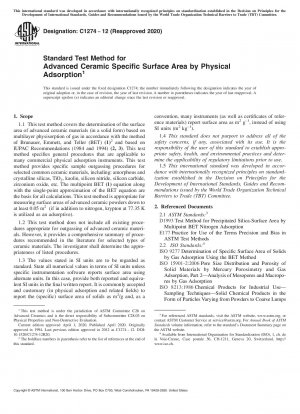ASTM C1274-12(2020)
Standard Test Method for Advanced Ceramic Specific Surface Area by Physical Adsorption
- Standard No.
- ASTM C1274-12(2020)
- Release Date
- 2020
- Published By
- American Society for Testing and Materials (ASTM)
- Latest
- ASTM C1274-12(2020)
- Scope
- 1.1 This test method covers the determination of the surface area of advanced ceramic materials (in a solid form) based on multilayer physisorption of gas in accordance with the method of Brunauer, Emmett, and Teller (BET) (1)2 and based on IUPAC Recommendations (1984 and 1994) (2, 3). This test method specifies general procedures that are applicable to many commercial physical adsorption instruments. This test method provides specific sample outgassing procedures for selected common ceramic materials, including: amorphous and crystalline silicas, TiO2, kaolin, silicon nitride, silicon carbide, zirconium oxide, etc. The multipoint BET (1) equation along with the single-point approximation of the BET equation are the basis for all calculations. This test method is appropriate for measuring surface areas of advanced ceramic powders down to at least 0.05 m2 (if in addition to nitrogen, krypton at 77.35 K is utilized as an adsorptive). 1.2 This test method does not include all existing procedures appropriate for outgassing of advanced ceramic materials. However, it provides a comprehensive summary of procedures recommended in the literature for selected types of ceramic materials. The investigator shall determine the appropriateness of listed procedures. 1.3 The values stated in SI units are to be regarded as standard. State all numerical values in terms of SI units unless specific instrumentation software reports surface area using alternate units. In this case, provide both reported and equivalent SI units in the final written report. It is commonly accepted and customary (in physical adsorption and related fields) to report the (specific) surface area of solids as m2 /g and, as a convention, many instruments (as well as certificates of reference materials) report surface area as m2 g–1 , instead of using SI units (m2 kg–1 ). 1.4 This standard does not purport to address all of the safety concerns, if any, associated with its use. It is the responsibility of the user of this standard to establish appropriate safety, health, and environmental practices and determine the applicability of regulatory limitations prior to use. 1.5 This international standard was developed in accordance with internationally recognized principles on standardization established in the Decision on Principles for the Development of International Standards, Guides and Recommendations issued by the World Trade Organization Technical Barriers to Trade (TBT) Committee.
ASTM C1274-12(2020) Referenced Document
- ASTM D1993 Standard Test Method for Precipitated Silica-Surface Area by Multipoint BET Nitrogen Adsorption
- ASTM E177 Standard Practice for Use of the Terms Precision and Bias in ASTM Test Methods
- ISO 18757 Fine ceramics (advanced ceramics, advanced technical ceramics) - Determination of specific surface area of ceramic powders by gas adsorption using the BET method
- ISO 9277 Determination of the specific surface area of solids by gas adsorption — BET method*, 2022-11-08 Update
ASTM C1274-12(2020) history
- 2020 ASTM C1274-12(2020) Standard Test Method for Advanced Ceramic Specific Surface Area by Physical Adsorption
- 2012 ASTM C1274-12 Standard Test Method for Advanced Ceramic Specific Surface Area by Physical Adsorption
- 2010 ASTM C1274-10 Standard Test Method for Advanced Ceramic Specific Surface Area by Physical Adsorption
- 2006 ASTM C1274-00(2006) Standard Test Method for Advanced Ceramic Specific Surface Area by Physical Adsorption
- 2000 ASTM C1274-00 Standard Test Method for Advanced Ceramic Specific Surface Area by Physical Adsorption
- 1995 ASTM C1274-95 Standard Test Method for Advanced Ceramic Specific Surface Area by Physical Adsorption
